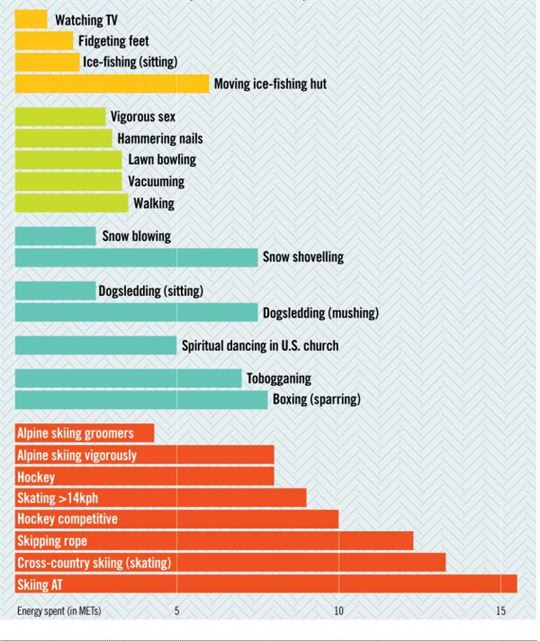Can you actually lose weight on a ski holiday given downhill skiing isn’t considered an aerobic sport? It turns out that skiing a full day can burn many more calories than I thought.
The Compendium of Physical Activities is a database created by Dr. Bill Haskell, a Stanford University professor in 1993 (and updated in 2000 and 2011) that lists the relative energy spent, given in METs, for a wide range of recreational activities. The base measurement is 1 MET, the amount of energy expended by an average-sized person sitting in a chair for an hour. To convert METs to calories, just multiply the METs for the activity by your weight in kg. For instance, one MET would equal 80 calories for an 80 kg individual.
The list with corresponding METs is comprehensive and includes activities such as playing darts and being a passenger on a snowmobile (both consume 2 METs per hour). Alpine skiing, on the other hand, has an energy expenditure that varies between 4 and 8 METs per hour, depending on the slopes, how aggressively one tackles them and, I suppose, the lift lines. The amount of energy consumed while skiing powder, bumps or running slalom gates is at least double the amount spent on a soft groomer. Even when correcting for time spent in lineups and on lifts, this would, for average-sized skiers and slopes, equate to about 1,000 to 1,400 calories for a seven-hour day. This is close to the calories spent on a one-hour run.
How about the bonus calories burned when exercising in cold weather? I always thought that one spent up to 30 per cent more calories exercising in below-freezing temperatures. I was surprised to discover a negligible amount of extra calories is burned running in winter versus summer. The exception would be if you’re cold enough to actually start shivering. The muscle used when shivering can boost your calories burned four-fold. Too bad shivering is such a miserable experience.
So why don’t I lose any weight on ski trips? It may have something to do with my après-ski consumption of fondue, nachos, beer, wine, etc. Nevertheless, it’s reassuring to know that it’s theoretically possible to actually slim down during my next ski trip. Maybe I can try in 2019.
Dr. John Foote is an emergency room physician at Toronto’s Mount Sinai Hospital and a Devil’s Glen skier.




